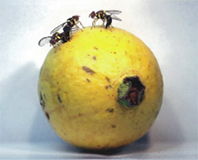Read the latest information on
Foot-and-mouth disease

Fruit flies love guava, so researchers have developed a lure based on the key attractants in this fruit. Photo by Jaye Newman
It’s been described as the gaping hole in the toolbox for fruit growers – an effective lure and kill device for female Queensland fruit fly (Qfly).
Currently lures attract only male fruit fly, through the use of a pheromone-like chemical called Cue-Lure.
While this is helpful for monitoring Qfly populations, it is the female fruit fly that does the damage by stinging fruits to lay her eggs.
Fortunately, research over the past few years is making a concerted effort to tackle the problem. A unique collaboration that brings together domestic and international researchers and a nationwide network of Australian fruit growers has picked up the ball, aiming to develop a field-effective female attractant.
Already, a number of synthetic blends are showing promise in trials in field cages, and comprehensive field evaluation of a lure-and-kill device is about to begin.
“Fruit flies just love guava,” said Associate Professor Paul Cunningham from AgriBio in Melbourne.
“Using chemical analysis, we have developed a prototype lure based on the key attractant volatiles in this fruit, those which signal ripening,” he said.
“We found that a blend of three volatiles was highly effective at attracting female flies, whereas individually they had no effect.”
Developing a female attractant is a far more difficult problem than attracting the males.
“To catch the females, we have to out-compete the odours of an orchard full of fruit,” he said.
“This is just the first version of our blend and we are already looking at ways to improve the formula.”
The physical trap itself has been designed to suit grower requirements – it needs to withstand field conditions, be practical to use and be commercially viable.
Field trials will help establish how many are required in an orchard, and the best placement for effective control.
“We realised that this research meant pulling out all the stops and venturing into completely new territory in designing lures,” said Paul.
“We’ve begun a really exciting collaboration with Swedish researchers on the application of optical imaging technology to lure development.
“For the first time, we have been able to probe into the fruit fly brain and use imaging on live insects to see how different odours evoke different responses. There is enormous potential to use these methods to screen potential attractants – a highly precise way of developing new lures that could be applied to many other insect pests and biosecurity threats.”
The new lure and kill system has major potential for monitoring and surveillance as well as reducing Qfly damage, especially in urban environments that are harder to control.
Further work will look at how the technology can be integrated into Qfly control practices, such as helping to assess the success of Sterile Insect Technigue (SIT) programs.
Market access is another area where the system can have major benefits, according to Andrew Finlay, chair of Summerfruit Australia.
“Increasingly, export destinations for Australian stone fruit are requiring phytosanitary protocols, including monitoring, for a number of pests and diseases of concern including a number of fruit fly species,” he said.
“An effective attract and kill lure for female fruit fly would be a valuable tool in helping to meet these phytosanitary protocols.”
The project was a Plant Biosecurity CRC initiative.
Project partners are AgriBio (the Centre for AgriBioscience, a partnership between the Department of Economic Development, Jobs, Transport & Resources and La Trobe University), the Queensland Department of Agriculture and Fisheries, Queensland University of Technology, Stockholm University and Summerfruit Australia.